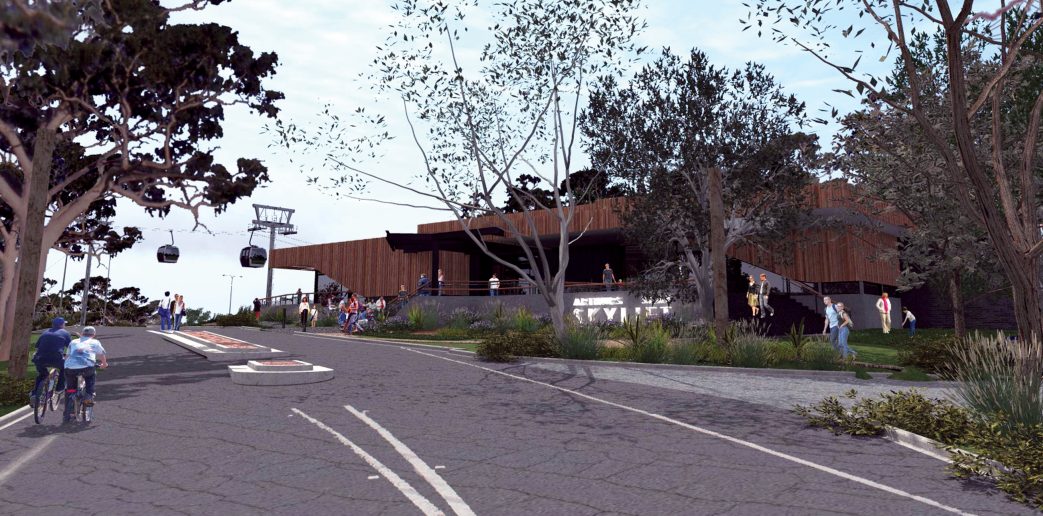REPLACEMENT of trees and bush cleared for the proposed $14 million Arthurs Seat chairlift gondola could come from three nearby shire reserves, says gondola chairlift spokesman Simon McKeon.
Mr McKeon, one of four shareholders of Arthurs Seat Skylift Pty Ltd, revealed the “native vegetation offset” plan at a public meeting last week organised by the Association for Building Community in Dromana.
It was the first public meeting since Mornington Peninsula Shire put Skylift’s plans on display for public comment.
Mr McKeon said 55 hectares of “shire-controlled” land had been identified by shire and Parks Victoria officers as a suitable vegetation offset for clearing at the bottom station, the 14-16 metre wide gondola corridor up Arthurs Seat, and the top station with its 100-seat cafe.
He said the land would be transferred from shire ownership to Parks Victoria and be included in Arthurs Seat State Park.
Later in the week, the shire’s manager of statutory planning, Angela Hughes, told The News the “potential transfer of shire-controlled land into Arthurs Seat State Park has been raised as one potential option to achieve the native vegetation offset required by this proposed development”.
She said this would have the benefit of “keeping the offset in our community and may provide a higher degree of protection for the land”.
The 55ha (140 acres) was given to the Shire of Flinders in 1974 when a developer subdivided land west of Purves Rd between Seamists Drive and Waterfall Gully Rd.
The land is zoned green wedge and would unlikely ever be rezoned for homes but Lot 15 in the subdivision sold for $1 million three years ago. This would make the 55ha worth at least $8.8 million if it ever came on the open market.
Asked about its value, Ms Hughes said the council “would have to follow a statutory process to consider the potential ownership of this land, which may include putting a nominal value on [it]”.
At the ABCD meeting, Mr McKeon told more than 130 people the project would revitalise the state park, create an internationally recognised attraction, and boost the peninsula’s economy through tourism and employment.
The fully enclosed 40 gondolas carrying up to eight people each would run all year round and could operate at night, he said.
Mr McKeon’s presentation covered vegetation removal, bushfire, noise, traffic, visual impact and parking.
He said reports covering these topics had been submitted with the planning application, which was available on the shire’s website.
But a flora and fauna assessment had been delayed due to changes in state government rules and would be submitted to the shire in about 10 days.
Angela Hughes said the chairlift planning application had been received in November 2013 but the shire had asked for additional information on 19 December.
“All of the requested information was received by council by 7 February 2014, except for the revised flora and fauna assessment”.
She said the assessment had been delayed “due to recent changes to the planning framework for the assessment of native vegetation offset provisions in the planning scheme”.
Mr McKeon said Skylift’s architect James McGann had redesigned the top and bottom stations so they had a reduced visual impact from those shown in May 2011.
Skylift CEO Hans Brugman had been “engaged with the CFA” since 2008, before Black Saturday and the subsequent royal commission, and the company was focused on fire safety.
Skylift consultants had estimated the gondola chairlift would attract 159,000 people a year but Mr McKeon said it was not in their interests to have people queueing or turned away. The company would concentrate on promoting “mid-term and midweek” rides.
Mr Brugman confirmed previous statements made by Mr McKeon that the ride could be evacuated in 7 minutes in the event of bushfire.
“The gondolas will move at 1 metre a second for the 20-minute one-way trip but top speed is 3 metres a second,” he said. Gondolas detach from the cable at the top station and take 2 minutes to move through the station.
Mr McKeon and Mr Brugman answered some tough questions from the audience, many of whom were skeptical of the proposal.
The group Friends of Arthurs Seat appears to be the main opposition. Consisting mainly of Arthurs Seat residents, the group says Arthurs Seat is “a grand piece of natural history and is at risk of being irreversibly damaged” by being “turned into an industrial and commercial hub”.




